Keeping an eye on the USB meter decreasing current until it’s nearly time…
Yeah I’m a meter watcher too ![]()
Here’s what the USB charging current looked like on my S1 Mini battery.

These are tempting, but the bitty little charger in there makes me nervous.
I’m wondering if anyone has been putting these through multiple charge cycles, and can speak to reliability of charging yet?
I’ll hang up and listen.
I own 2 Fenix ARB-L 16 and they have been through 30-40 cycles each, all charged by their USB port and no problem so far. I never tried them in a charger though.
fair enough place to start, I think your next move would be to try one yourself… My experience is very positive.
Ive got half a dozen USB rechargeable cells, couple Fenix brand, couple Olight brand, couple Lumintop brand. Been using them exclusively for the past 3 months. They work great!
I check them with a voltmeter after they are full, and they have always been up to 4.1x, never 4.2… so I trust they dont overcharge. As reported in other posts above, the charge rate is less than .5c, so all good there too… the batteries do not get hot while charging either. I also like that the Overdischarge protection works as intended, cutoff is at 2.7v
I dont recommend the Fenix, not because they dont work, only because they are longer. Here is the Voltage on a freshly charged Fenix USB 16340:
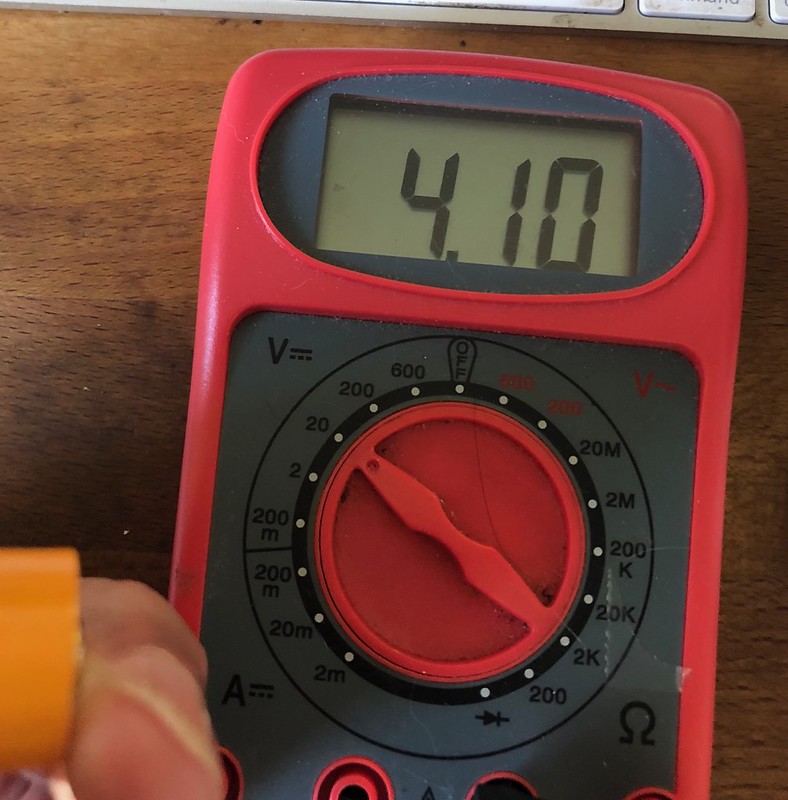
I like the Olight brand very much, they have also been 100% reliable. In this next photo you can see an Olight USB 16340 while charging, plus one of the Lumintop cells in a PicoPull XL capsule, that I also really like. There is also a CR123 in an Oveready 18350 capsule, and the Olight Universal Magnetic charger in the pic:
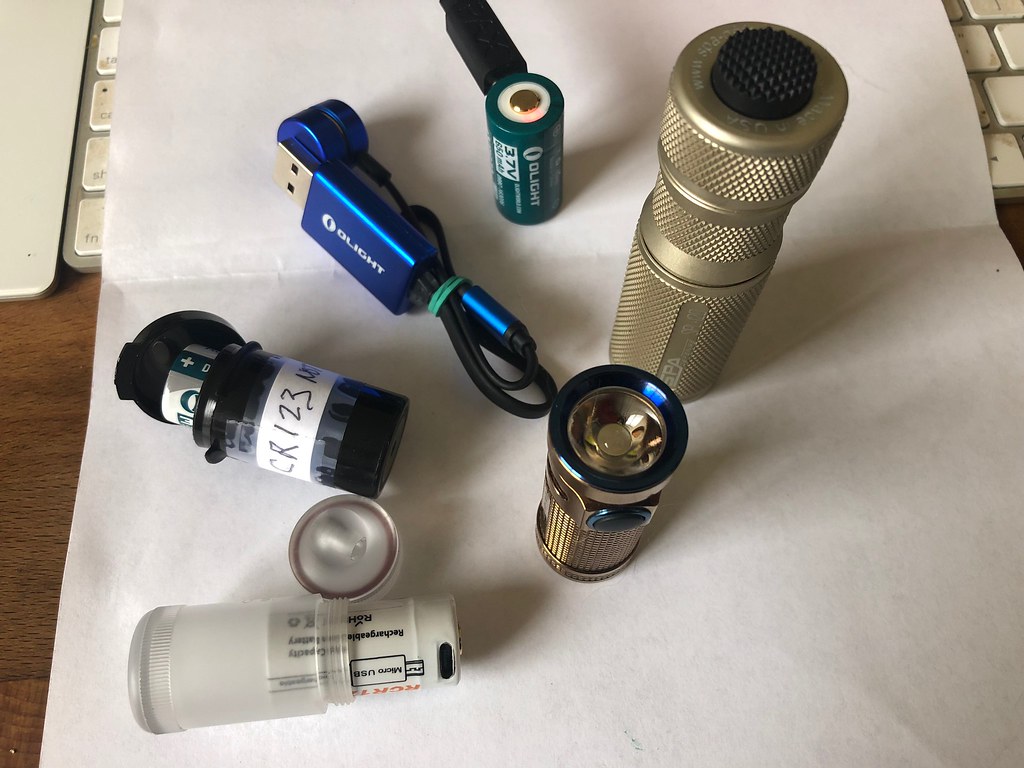
The Lumintop Brand that were included inside my Utorch S1 Mini have also been consistent at not overcharging. With one glitch, the Red charge indicator LED on one of the Lumintop batteries, went through part of a charge cycle without turning on. But the inline USB charge indicator I use, showed it was charging. About 5 minutes later, the Red charge indicator light came on.
The Green Charged LED worked. I have continued to use the battery without issue, and on the next recharge the charge indicator worked fine…

At no point did the battery get hot, and even while the charge indicator light was on break, I could see on my charge current meter that the charge rate was proceeding fine, not too high, not too low. As Goldilocks said, Just right.
Lastly I have been using the charge circuit in my PT-16 and PT-18, which is USB and looks very similar to the USB batteries, for over a year, without a single issue.
afaict, a charge circuit disc is reliable at not charging too fast, and reliable at stopping the charge below 4.2v.
I have also watched the voltage and current meter that I have inline with my USB battery charge cable, and Im happy to report that once the cell is full, the charge rate drops to complete Zero. I like that. I did not want to see a constant ongoing charge current… So again, very happy with the design of the charging discs. I still dont leave LiIon on charge unattended, and I charge on a metal surface, in case they were to “vent with fire”, but I have had no hint of any thermal runaway.
I recommend the Olight brand USB charging Protected 16340 without any reservations.
Shortly I will receive a Klarus Mi1c, that also comes with their own labeled version of the USB battery. If there is any problem, I will report back. Until then, unless you can find any other issues reported, I would say the USB chargeable 16340 are completely safe to use, and I give 2 thumbs up.
imho it is safe to say that there have been zero overcharging issues with the USB charging circuits. I like the USB batteries very much and recommend them highly. Super convenient to be able to charge from an Android phone cable, no need to carry a separate charger. otoh, the USB 16340 cells also work fine on a standalone charger. Zero issues there either.
Here is a little kit with spare batt and charge cable:

Lastly I can also charge the USB cells using the Olight Universal Magnetic charger… though imo it starts out a bit high, slightly over 1C:

it tapers off reasonably well as the charge level rises. The reason I bought the Olight Universal Charger is because it is versatile, and will charge not only LiIon, but also Eneloop. Whats not to like?![]()
Here is the Olight Universal Magnetic charger, showing zero current when the charge is complete, as confirmed by the green light.

Here are some of the various charging options I have mentioned in this post:
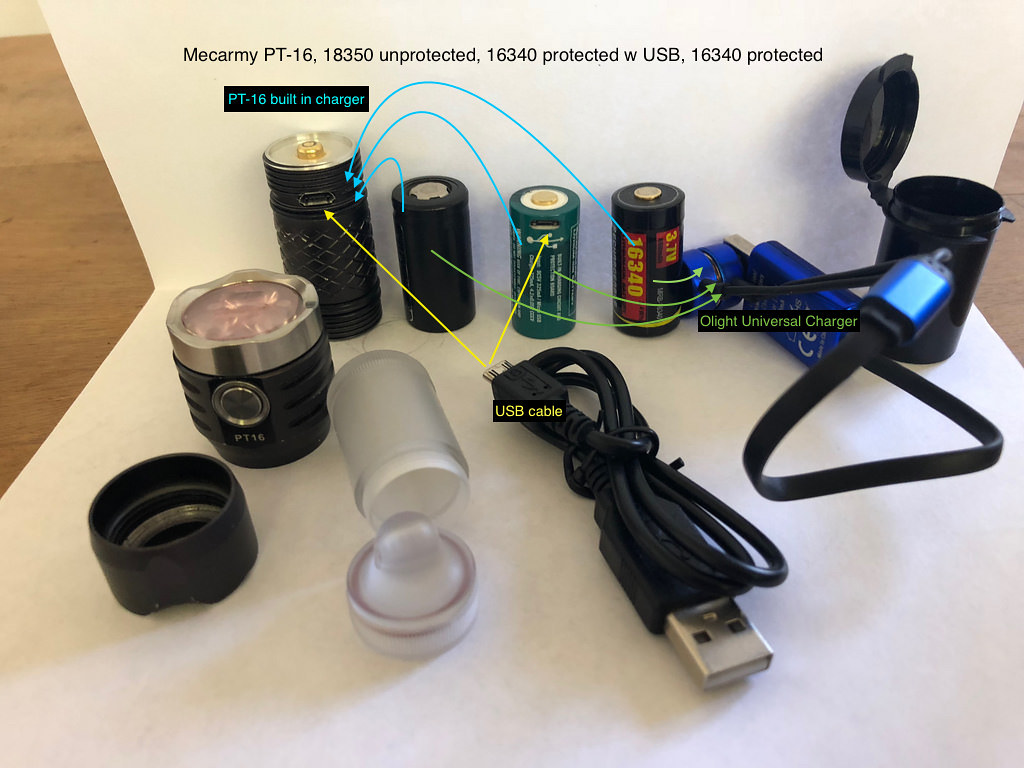
and a Camping Kit with multiple choices for charging, battery carriers, and chemistries
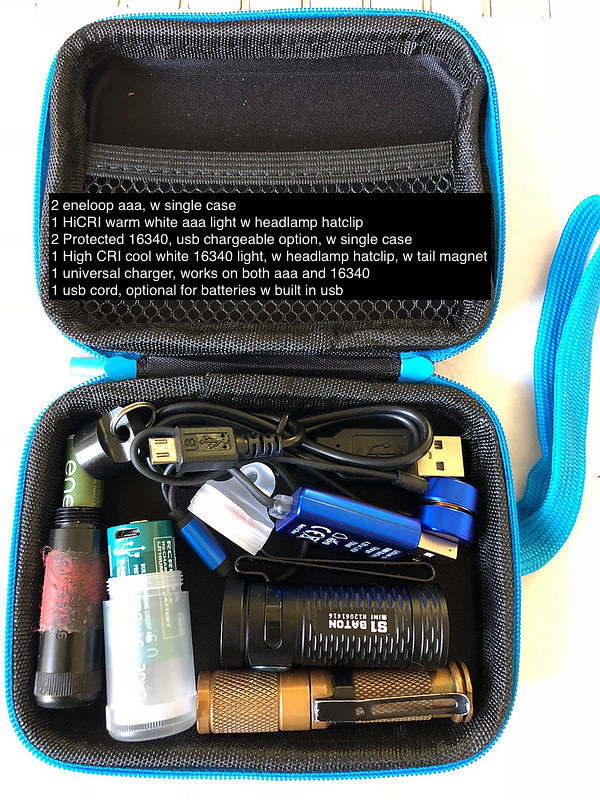
I prefer charging my basic cells in a charger. I don’t like on-cell USB charging because things being smaller, there’s more of a chance something in the charging module craps out, thus rendering the cell useless. Same with PCBs and perhaps dropping a cell on the ground.
If I have to have on board USB charging for something, I guess I’d prefer the light to do the charging, all things being equal?
I get that they’re totally convenient for many people and while I have a lot invested in chargers, some of mine: Liitokala 100, Xtar MC1+ and Xtar XP-1 Hummingbird aren’t all that inconvenient to carry around.
Better faster/chargers, as well.
Chris
I respect you have your own comfort zone, however, the USB charging disc in my PT lights seems to operate exactly the same way the charging discs built into the USB batteries operates.
The disadvantage of the charging disc being in the light, is that it disables the light, while it is acting as a charger… That is a big disadvantage, for me. I greatly prefer the ability to charge the USB 16340 outside the light, so I can continue to use the light while the Battery is charging separately.
I also respect that you have more sophisticated chargers, that can give you capacity data, which the USB charging ports on Lights or Batteries, does not provide.
Choices are good. Collect them all!![]()
I’ve got two of the CooYoo Quantum type lights that Ven gave and they (lost the CooYoo during Irma) never got close to charging up to 4.20v, which isn’t unheard of with external chargers either, but they generally get closer, IME. Then there’s the item of speed and light chargers tend to be on the slower side of things.
Like I said, I don’t mind choices if they’re rendered properly, it’s just that I don’t seek out lights with internal chargers, I don’t seek out lights with fixed, or proprietary batteries and I don’t seek out cells/batteries with on board charging modules on them.
I have lots and lots of cells and chargers here, so I’m not speaking from trepidation, or inexperience.
But if we all liked the same things, it would be a boring world, wouldn’t it?
Chris
Im new to LiIon, I dont have a lot of older cells, I dont have unprotected cells, and I dont rely on external chargers.
If a charger falls short of 4.2v, I consider that safer.
If a charger works too fast, I consider that less safe.
since Im new to LiIon, and 16340 in particular, All my cells have USB rechargeability. It is imo, the newbie friendly, more modern option.
Not to say that there arent plenty of old timers that do fine with chargers and unprotected cells… Im just conservatively cautious about LiIon use, and imo the USB Protected 16340 are a no brainer… No charger needed, whats not to love? These are not proprietary, that is, they work in ALL my lights, they are not tied to a specific light model, nor to a specific charging strategy.
The only proprietary battery mentioned in this thread is the S1R battery, which I do not recommend at all. Also this thread is specifically about the USB Rechargeable cells, it is not about IMR, or other chemistries, nor about non USB batteries.
I think the USB batteries are a totally viable option, and imo lights that include them make great gifts for newbies, who may not need to learn about chargers, voltmeters, and the safety strategies for using UnProtected cells.
Jon, I have no experience with integrated charging cells, but if a typical cell charge is closer to 4.10 V on the meter, I would begin to suspect the meter calibration (or lack there of). I know my meter measures about 0.07V higher than a calibrated meter when measuring around 4.2V. It could be that your meter is measuring a bit on the low side, which is why you always measure voltages below 4.2V. Or it could be that your meter is very accurate, and all the cells you bought have the charge cut off set below 4.2V. I hope it is the latter. ![]()
In built charging rules! ![]()
Imagine taking out your cell phone battery and having to have the charger with you every time to charge it :weary:
This is also why we carry multiple lights, one on charge, one in use ![]()
Very rarely seen the smaller cells maintain 4.2v after a little rest out the charger except some HQ 18650’s, a little undercharging is good for the cells too.
Im new to LiIon, I dont have a lot of older cells, I dont have unprotected cells, and I dont rely on external chargers.
If a charger falls short of 4.2v, I consider that safer.
If a charger works too fast, I consider that less safe.since Im new to LiIon, and 16340 in particular, All my cells have USB rechargeability. It is imo, the newbie friendly, more modern option.
Not to say that there arent plenty of old timers that do fine with chargers and unprotected cells… Im just conservatively cautious about LiIon use, and imo the USB Protected 16340 are a no brainer… No charger needed, whats not to love? These are not proprietary, that is, they work in ALL my lights, they are not tied to a specific light model, nor to a specific charging strategy.
The only proprietary battery mentioned in this thread is the S1R battery, which I do not recommend at all.
Admittedly, you’re new to this stuff and therefore inexperienced.
Slower isn’t safe per se, it’s just slower, since cells have a charging range speced in.
4.20v (+/- .05) is the standard. Less isn’t safer.
With 16340s and PCBs, we’re talking generally ChiCom li-co chemistry, which is the reason you’re using a PCB in the first place. With modern lipstick lights drawing higher currents, li-co isn’t ideal for that application, since li-co is a <2A chemistry.
If you’re not running on high/turbo, all that often, then li-co can be fine and offer slightly more runtimes.
Anyhow, stick with what you’re comfortable with, but there’s more than one way to skin a cat.
Chris
… I have no experience with integrated charging cells
…
It could be that your meter is measuring a bit on the low side
most people dont have experience with USB cells. That is why I started this thread, to share my experience and appreciation for the option. I recommend you try them.
I agree my meter may be reading low, Im not worried about that. The bottom line is the USB charging circuits work great, they dont overcharge, they dont overheat, and they dont charge at too high a rate.
I cannot find anything not to like about my USB rechargeable cells. In fact, I wont buy cells without the feature anymore.
and fwiw, the Olight S1 Mini, the Klarus Mi1C, and the Utorch S1 Mini, all include a USB cell in the purchase price… I think they are a very good buy.
I recall you were selling one of the proprietary IMR batteries for use in an UnProtected light a while back. I tried to tactfully suggest that was a bad idea. I still think it is a bad idea to use the S1R battery in other models that lack built in protection.
The beauty of the USB rechargeable cells, besides the convenience of charging, is that they are Protected. That means they can be used in all the many Unprotected lights that are being sold, without having to use a Voltmeter at all, not to test discharge level, and not to test charging cutoff voltage.
There really is no downside to the USB Cells, that I have found.
I still respect that people are leery of new technology, and or loyal to their old chargers… choices are good.
This is not a general case, but please look here:
I have few more models that i don't really use. Maybe i spend some time with them then share my findings over there later. freeme, can you post it here Flashlight with in-built charger OR flashlight + battery with in-built charger? ? Or can I quote you to put on that thread?
freeme said he wanted to check further on the battery. Still, that happened!
This is not a general case, but please look here:
ENEDED - #271 by freemefreeme said he wanted to check further on the battery. Still, that happened!
thank you for sharing that info
I would definitely not be happy if my batteries did that
I have not tried storing my 16340 cells, unused for 3 months… my cells are all actively used and rotate through my lights
if any new info arrives, please do share… It is unclear whether freeme’s cell had a problem related to the USB portion of the design, or some other factor
your post is totally on topic, and I appreciate any info regarding failures of Cells with built in USB charging
especially if the failure can be attributed directly to the charging chip, which may or may not be what caused the failure freeme reported
I always appreciate your contributions
This is not a general case, but please look here:
ENEDED - #271 by freemefreeme said he wanted to check further on the battery. Still, that happened!
Anything can go up in smoke. I’ve seen well regarded chargers actually melt down, but otherwise, the majority of them are just fine.
There are legitimate reasons for me, not to buy ‘on board charging’ cells, but one’s guys meltdown isn’t one of those reasons.
‘Iza got 99 problems…’
Chris
I recall you were selling one of the proprietary IMR batteries for use in an UnProtected light a while back. I tried to tactfully suggest that was a bad idea. I still think it is a bad idea to use the S1R battery in other models that lack built in protection.
I still am. The buyer could choose to buy the light without the battery, as I originally listed, or buy the light with the battery and not use the battery, or offer to buy just the light at a lower price, or be conscientious of what they have and use the two together. The buy could choose to use the battery in an protected light also. They will certainly see your warning in the buy thread, as I haven’t relisted the light.
IMR is great for high drain, protected lights like the S1R, or maybe your D4?
Protected USB rechargeables are great for low drain unprotected lights such as our Olight S Minis ![]()
I have also watched the voltage and current meter that I have inline with my USB battery charge cable, and Im happy to report that once the cell is full, the charge rate drops to complete Zero. I like that. I did not want to see a constant ongoing charge current… So again, very happy with the design of the charging discs. I still dont leave LiIon on charge unattended, and I charge on a metal surface, in case they were to “vent with fire”, but I have had no hint of any thermal runaway.
I recommend the Olight brand USB charging Protected 16340 without any reservations.
Shortly I will receive a Klarus Mi1c, that also comes with their own labeled version of the USB battery. If there is any problem, I will report back. Until then, unless you can find any other issues reported, I would say the USB chargeable 16340 are completely safe to use, and I give 2 thumbs up.
imho it is safe to say that there have been zero overcharging issues with the USB charging circuits. I like the USB batteries very much and recommend them highly. Super convenient to be able to charge from an Android phone cable, no need to carry a separate charger. otoh, the USB 16340 cells also work fine on a standalone charger. Zero issues there either.
Here is a little kit with spare batt and charge cable:
Lastly I can also charge the USB cells using the Olight Universal Magnetic charger… though imo it starts out a bit high, slightly over 1C:
it tapers off reasonably well as the charge level rises. The reason I bought the Olight Universal Charger is because it is versatile, and will charge not only LiIon, but also Eneloop. Whats not to like?Here is the Olight Universal Magnetic charger, showing zero current when the charge is complete, as confirmed by the green light.
Here are some of the various charging options I have mentioned in this post:
and a Camping Kit with multiple choices for charging, battery carriers, and chemistries
The chargers and batteries all have LEDs on indicating full charge. I don’t think they’re drawing power from the battery, so your meter probably can’t detect the small current. Are you sure there’s no trickle charge?
Are you sure there’s no trickle charge?
I have no evidence of Trickle Charging.
Share if you find any evidence of Trickle Charging.
In any case, folllowing those protocols, there is no possibility of a trickle charge: ![]()
Do NOT charge LiIon unattended.
Do NOT charge LiIon overnight, unattended.
Do Disconnect the charging cable when the charge indicator says Charging has Stopped.
another example,
the charging chip on my PT-18, immediately after it turned green:

Battery is still connected to charging cable, the indicator light is green, and there is Zero Amps charge rate, but 4.99v:
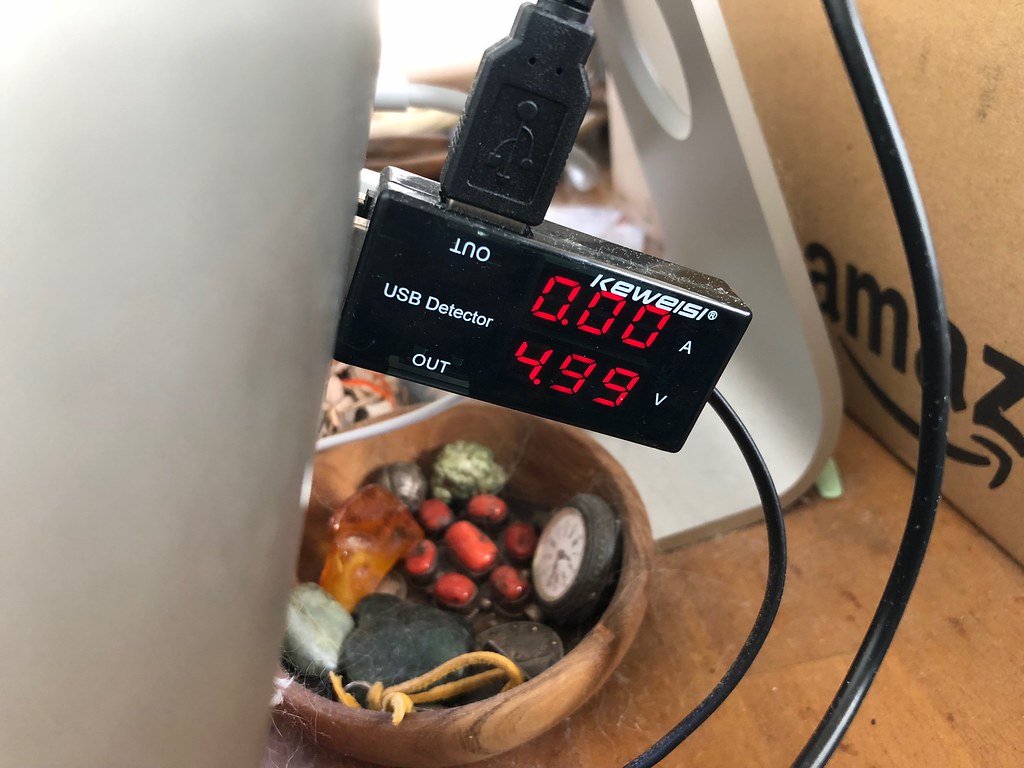
4.15 volts from the fully charged battery, immediately after unplugging the charge cable

Charging cable disconnected from battery, Zero Amps charge rate, but now 5.03v:
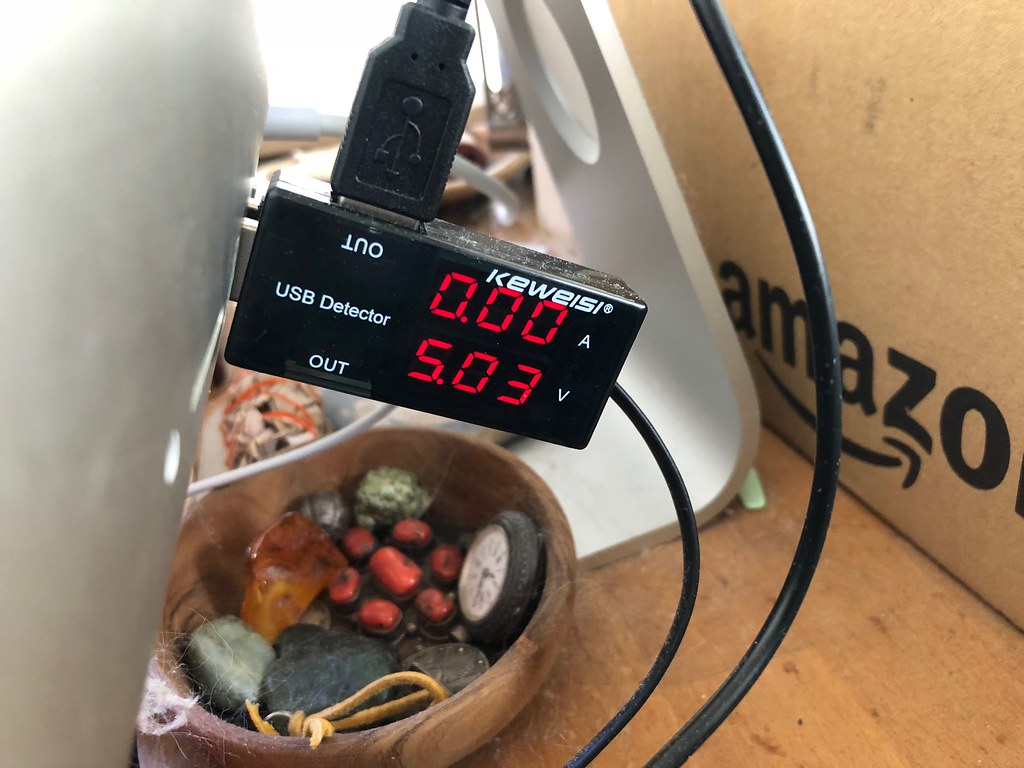
As you suggested, the status LED seems to be using Volts to light the status light when the charge cable is plugged in… even though the charge status light is green, there are Zero Charging Amps indicated on the meter. I interpret that to mean that charging is switched OFF, and the Green Full Charge Status indicator light was being powered from the USB cable.